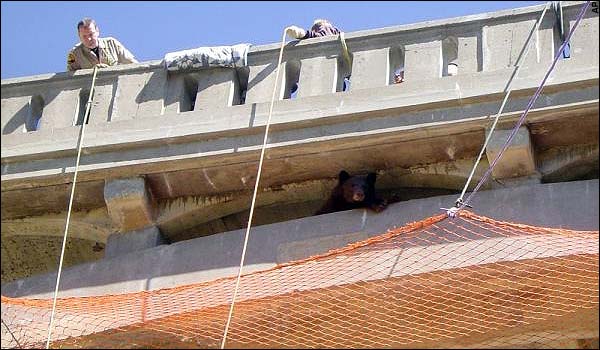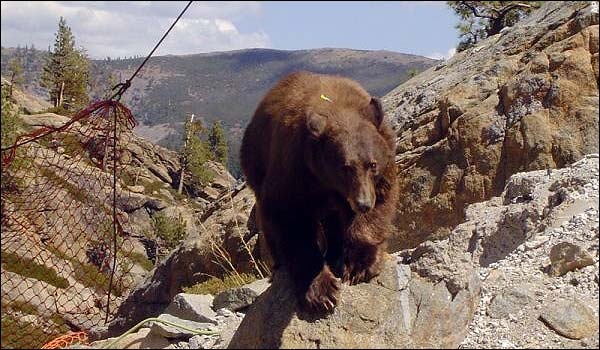
 Sitemap
Sitemap
As a matter of interest, here are a few words about bears.
I don't profess to be an expert on bears and the few months I spent in their backyard certainly doesn't make me one, but I did try and find out as much about them as I could before I set off and I
also made a few on the spot observations when the time came.
So here’s what I can tell you......
For most of the Pacific Crest Trail you will be in Black Bear country.
However, the northern part of the Cascade Range in Washington State and British Columbia is also home to a few grizzlies. (Brown Bear)
The good (or maybe bad) news is, there aren't many.
In all of the North Cascade Range, from southern British Columbia in Canada to Snoqualmie Pass (I-90) it is roughly estimated that there may be only 15 to 30 grizzly bears.
Both the Black Bear and the Grizzly are omnivorous, highly intelligent and each have individual traits, much like humans.
They have an excellent sense of smell, seven times stronger than a bloodhound, making them capable of detecting scents from miles away and they possess eyesight at least as good as a human's.
Both are powerful and extremely protective of their young.
Both bears can vary greatly in colour - Black Bears are not necessarily black and grizzlies not always grizzled, so it can be easy to make a mistake in distinguishing between the two
species.
Some features that help identify the different species are,
1. The adult Grizzly is larger than the Black Bear.
2. The Black Bear is a far more agile tree climber than the adult Grizzly.
3. Grizzlies have a hump at the shoulders, their facial profile is concave (curving inwards) rather than straight and they have longer claws.

4. The forepaw print of the two bears is different, although both rear prints are the same.
(With the foreprint, if you draw a line from the base of the outer (left) toe to the highest point of the palm pad, the print of the inner (right) toe of the Black Bear will fall below, or partially
below this line, whilst the Grizzly's inner toe print will remain above it.)
The bad news is, there are no precise rules on what to do if you find yourself up close and personal with a bear.
However with a bit of luck, the following advice will help the situation.
Remember, bears are individuals and as such will behave differently in different situations.
1. Be wary in places where there are berries, or the carcass or remains of an animal - you could be wandering in the bear's pantry.
2. Try not to startle or surprise a bear. As mentioned in, “Dances with Marmots”, they don’t like surprises and tend to rip your head off if you give them one.
Make your presence known by talking, singing, or clapping.
Don’t make high pitched noises as these may attract bears.
Some hikers use bells, but I’ve heard that bells may arouse a bear’s curiosity...and you don't want to be arousing that.
3. You could encounter bears at any time of the day but be particularly alert if you're plodding along around dawn or dusk.
4. Bears are less likely to approach a group of people. This is not much help if you're doing a solo hike. Try and develop multiple personalities!
5. If hiking with your dog, keep it under control - Loose dogs monster wildlife and also may lead a bear back to you.
6. Be careful traveling off trail. Bears will rest next to logs, in dense undergrowth, or in a grassy meadow.
Bears will also use trails. (they'll be the hairy ones without packs.)
7. If you spot a bear and the bear has not seen you, calmly withdraw, talking aloud to make it aware you are there and are moving away.
(I’m not so sure about the, “making it aware that you are there” bit, I think I’d be inclined to withdraw quietly and remain anonymous for as long as possible!)
Most bears will leave when they see or hear you.
8. Never come between a bear and her cubs, or attempt to retrieve any food a bear has stolen from you - he will consider it his food .
9. When a bear stands up it is usually to help identify what you are. It is not meant as an immediate threat.
10. If approached, do not scream or run - You won’t outrun a bear. Black and Grizzly Bears can easily reach speeds of 30mph.
Running may only trigger a pursuit response by the bear and screaming may also aggrevate the situation.
11. Bear repellents (even if effective) only work at very close range, so if it doesn’t work or you miss your target, you’ll be caught standing up looking threatening, and in deep poo. (Oh dear!)
12. Avoid direct eye contact. This could be seen as a threat.
Talk in low soothing tones, whilst slowly backing diagonally away.
If the bear follows, stand your ground. Generally, if you stand your ground, the bear will leave - though the bear may make a couple of, “feint” charges before veering off.
Wild bears rarely actually attack unless feeling threatened.
13. Most attacks thought to have been predation involved Black Bears, most attacks by Grizzlies have been defensive, especially by females with cubs. There have been more deaths attributed to Black Bears in the US than to Brown (Grizzly) bears. This is probably due to them being more numerous and often their habitat is less remote than the Grizzlies.
14. If attacked by a Black bear, fight back with whatever weapon you can muster. Aim for the bear’s eyes or nose.
Do not play dead as the Black bear will attack dead prey and attempt to eat you or drag you off.
15. Some people have survived Grizzly attacks by dropping into a curled up position, protecting their face between their knees with their hands clasped over the back of their neck. If you
assume that position and the bear takes you out of it, try to resume that position again.
Remain in a motionless position for as long as possible, because if you move and the bear sees you move, it may have another go at you.
Hopefully, the bear will see that you are not a threat and will leave you alone.
If however, it continues it's attack, it may be seeing you as, “dead prey” and you may have no choice but to attempt to fight back. Go for the nose and eyes - good luck!
16. Don’t sleep in clothes that contain food odours.
Don’t cook in or near your tent.
Sleeping in a tent is safer than sleeping in the open.
17. Never keep food or anything aromatic in your tent.
Hang your food, garbage or anything aromatic up a tree and away from your campsite.
Carry 50 feet (15 metres) of line with you. Biff your food and aromatics into a bag and hoist the lot up a tree and off the ground.
Ideally the tree should be at least 100 yards (90 metres) away from your tent and if possible downwind. Suspend it at least 10ft (3 metres) from the ground and 4 ft (1.2 metres) from the trunk.
Unfortunately, there will be some areas where this criteria is a bit hard to fill!
18. Don’t use scented deodorants or shampoos - basting your bits with tempting smelling flavours may be pushing your luck a bit.
19. Lastly, I had heard one theory that, “laying your scent down”, by urinating around the perimeter of your tent would help deter a bear from approaching the tent.
Whether or not this is true, I can’t say for sure, but I did this on my hike all through the Sierra Nevada of California and the Cascades of Oregon and Washington and even though I was hassled
by bears on more than one occasion, they never did cross the line.
I’ve since heard that urine attracts wildlife, (oops!) I know for sure it attracts deer - they seem to find it rather tasty - but thankfully they turned out to be even more nervous than
me.
Remember, it is you who are in the bear's back yard - be polite.
It’s also good to remember that bear attacks are rare, and for every person killed by a Black Bear in North America, there are over 60,000 homicides - maybe a, “Hiker Repellent” is
more appropriate.
In the past 100 years there have been over 50 recorded killings of humans by Black Bears and a slightly lesser number by Brown/Grizzly Bears. There is an interesting article on this at Wikipedia
The only other wildlife that may possibly give you a bit of a rev-up is the cougar and there have been rare fatalities, the latest being in 2018 (though you’ll probably never see one) or the rattlesnake. (which you probably will see)
The poor maligned rattler, whom you’re likely to meet at elevations below 7000ft, is the gentleman of snakes, and will generally give you a fair audible warning that you are starting to annoy
him. So unless you inadvertantly step on one, grab one, sit on one, or try and use one as a skipping rope, he shouldn’t harm you.
Coyotes (you’ll probably hear these, rather than see them) should pose no threat, unless you are extremely small, lying on the ground badly injured, or on the doorstep of a starving pack
suffering from rabies.





Cheers! George Spearing 

